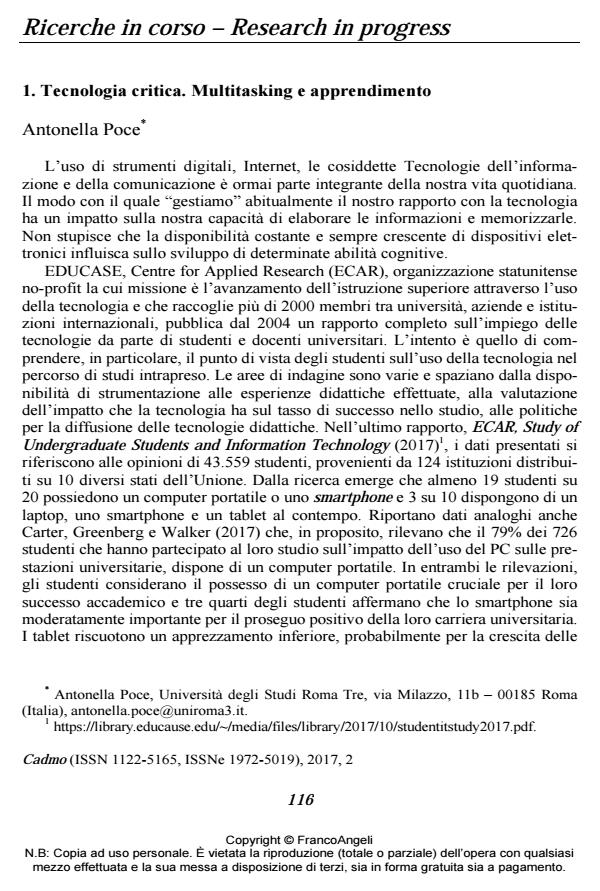Ricerche in corso
Titolo Rivista CADMO
Autori/Curatori Antonella Poce, Valeria Damiani, Nader A. M. Harb
Anno di pubblicazione 2018 Fascicolo 2017/2 Lingua Italiano/Inglese
Numero pagine 10 P. 116-125 Dimensione file 170 KB
DOI 10.3280/CAD2017-002012
Il DOI è il codice a barre della proprietà intellettuale: per saperne di più
clicca qui
Qui sotto puoi vedere in anteprima la prima pagina di questo articolo.
Se questo articolo ti interessa, lo puoi acquistare (e scaricare in formato pdf) seguendo le facili indicazioni per acquistare il download credit. Acquista Download Credits per scaricare questo Articolo in formato PDF

FrancoAngeli è membro della Publishers International Linking Association, Inc (PILA)associazione indipendente e non profit per facilitare (attraverso i servizi tecnologici implementati da CrossRef.org) l’accesso degli studiosi ai contenuti digitali nelle pubblicazioni professionali e scientifiche
- Barak, M., Lipson, A., Lerman, S. (2006), “Wireless Laptops as Means for Promoting Active Learning in Large Lecture Halls”, Journal of Research on Technology in Education, 38 (3), pp. 245-263.
- Brumby, D.P., Salvucci, D.D. (2006), “Exploring Human Multitasking Strategies from a Cognitive Constraint Approach”, in Proceedings of the 28th Annual Conference of the Cognitive Science Society. Mahwah (NJ): Lawrence Erlbaum.
- Carter, S.P., Greenberg, K., Walker, M.S. (2017), “The Impact of Computer Usage on Academic Performance: Evidence from a Randomized Trial at the United States Military Academy”, Economics of Education Review, 56, pp. 118-132, http://dx.doi.org/10.1016/j.econedurev.2016.12.005.
- Cristia, J., Ibarrarán, P., Cueto, S., Santiago, A., Severín, E. (2012), “Technology and Child Development: Evidence from the One Laptop per Child Program”, Inter American Development Bank, disponibile su http://www.iadb.org, u.a. 12/1/2017.
- Fairlie, R.W., London, R.A. (2012), “The Effects of Home Computers on Educational Outcomes: Evidence from a Field Experiment with Community College Students”, The Economic Journal, 122, pp. 727-753,
- Gulek, J.C., Demirtas, H. (2005), “Learning with Technology: The Impact of Laptop Use on Student Achievement”, The Journal of Technology, Learning and Assessment, 3 (2), Special Issue.
- Kirschner P.A., De Bruyckere P. (2017), “The Myths of the Digital Native and the Multitasker”, Teaching and Teacher Education, 67, pp. 135-142.
- Loh K.K., Kanai R. (2014). “Higher Media Multi-Tasking Activity is Associated with Smaller Gray-Matter Density in the Anterior Cingulate Cortex”, PLoS ONE, 9 (9), e106698. https://doi.org/10.1371/journal.pone.0106698.
- Mueller, P.A., Oppenheimer, D. (2014), “The Pen is Mightier than the Keyboard: Ad-vantages of Longhand over Laptop Note taking”, Psychological Science, 25 (6), pp. 1-10, DOI: 10.1177/0956797614524581
- Patterson, R.W., Patterson, R.M. (2017), “Computers and Productivity: Evidence from Laptop Use in the College Classroom”, Economics of Education Review, 57, April, pp. 66-79.
- Sana, F., Weston, T., Cepeda, N.J. (2013), “Laptop Multitasking Hinders Classroom Learning for Both Users and Nearby Peers”, Computers & Education, 62, pp. 24-31.
- Shapley, K., Sheehan, D., Maloney, C., Caranikas-Walker, F. (2009), Evaluation of the Texas Technology Immersion Pilot: Final Outcomes for a Four-year Study (2004-05 to 2007-08), Texas Center for Educational Research.
- Suhr, K.A., Hernandez, D.A., Grimes, D., Warschauer, M. (2010), “Laptops and Fourth Grade Literacy: Assisting the Jump over the Fourth-grade Slump”, The Journal of Technology, Learning and Assessment, 9 (5).
- Tombu, M.N., Asplund, C.L., Dux, P.E., Godwin, D., Martin, J.W., Marois, R. (2011), “A Unified Attentional Bottleneck in the Human Brain”, in Proceedings of the National Academy of Sciences, 108 (33), pp. 13426-13431, http://dx.doi.org/10.1073/pnas. 1103583108.
- ELGPN (2012), Lifelong Guidance Policy Development: A European Resource Kit, available at http://www.elgpn.eu/publications/browse-by-language/english/ELGPN_resource_kit_2011-12_web.pdf/ (last accessed December 27, 2017).
- ELGPN (2015), Guidelines for Policies and Systems Development for Lifelong Guidance. A Reference Framework for the EU and for the Commission, available at www.elgpn.eu/publications/browse-by-language/english/elgpn-tools-no-6-guidelines-for-policies-and-systems-development-for-lifelong-guidance/ (last accessed December 27, 2017).
- European Council (2004). Resolution on Guidance throughout Life, available at http://europa.eu/rapid/press-release_PRES-04-155_en.htm? locale=en (last accessed December 27, 2017).
- European Council (2008), Council Resolution on better Integrating Lifelong Guidance into Lifelong Learning Strategies, available at http://www.consilium.europa.eu/ueDocs/cms_Data/docs/pressData/en/educ/104236.pdf (last accessed December 27, 2017).
- European Parliament (2017), Skills Development and Employment: The Role of Career Management Skills, Available at http://www.europarl.europa.eu/RegData/etudes/BRIE/2017/607359/IPOL_BRI(2017)607359_EN.pdf (last accessed December 27, 2017).
- ILO (2004), Recommendation concerning Human Resources Development: Education, Training and Lifelong Learning, available at http://www.ilo.org/dyn/normlex/en/f?p=NORMLEXPUB:12100:0::NO::P12100_INSTRUMENT_ID:312533 (last accessed December 27, 2017).
- Skills Development Scotland (2012), Career Management Skills Framework for Scot-land, available at https://www.skillsdevelopmentscotland.co.uk/media/34749/career_management_skills_framework_scotland.pdf (last accessed December 27, 2017).
- Altoma, S.J. (1974), “Language Education in Arab Countries and the Role of the Academies”, in Fishman, J.A. (ed.), Advances in Language Planning, Yeshiva University, New York, pp. 279-313.
- Becker, C. (2007), Über Max Webers “Die protestantische Ethik und der Geist des Kapitalismus”. Munich: Grin Publishing
- Bosisio, C. (2010), Il docente di lingue in Italia: linee guida per una formazione europea, Milano: Mondadori.
- García-Sánchez, I.M. (2010), “The Politics of Arabic Language Education: Moroccan Immigrant Children’s Language Socialization into Ethnic and Religious Identities” Linguistics and Education, 21 (3), pp. 171-196.
- Haeri, N. (1995), The Sociolinguistic Market of Cairo: Gender, Class, and Education. Totnes: Kegan Paul International.
- Kaplan, R.B. (1966), “Cultural Thought Patterns in Inter‐cultural Education”, Language Learning, 16 (1‐2), pp. 1-20.
- Maamouri, M. (1998), Language Education and Human Development: Arabic Diglossia and Its Impact on the Quality of Education in the Arab Region, http://eric.ed.gov.
- Prosperi, A. (1988), “Educare gli educatori: il prete come professione intellettuale nell’Italia tridentina”, Publications de l’École française de Rome, 104 (1), pp. 123-140.
Antonella Poce, Valeria Damiani, Nader A. M. Harb, Ricerche in corso in "CADMO" 2/2017, pp 116-125, DOI: 10.3280/CAD2017-002012